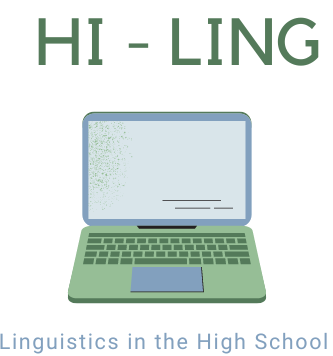HI-LING
LINGUISTICS IN THE HIGH SCHOOL

UNIT 2: VIOLATION OF MAXIMS
Module 11: Computational Linguistics
Computational linguistics is an interdisciplinary field that deals with the application of computer and machine learning methods to the processing of natural language. It aims to understand human language through algorithms and models to enhance tasks such as machine translation, text analysis, and automatic speech recognition.

linguistics and working with computers have nothing to do with each other? You thought wrong! Get an initial overview and immerse yourself in the world of computational linguistics!

The subfield of machine speech tagging is a method for automatically assigning grammatical information to the individual words of a text. It thus functions as a basis for understanding speech from computer-based aids.

Natural language processing (NLP) is the field dedicated to developing machines capable of interacting with human language, or data resembling human language, as it is presented, expressed, and structured.
Computational systems trained on vast amounts of textual data, capable of generating coherent and contextually relevant sentences by recognizing and predicting language patterns.


Bias is a crucial sub-field of research in computational linguistics. On the one hand, the discipline is challenged to analyse and reduce biases in its own processes. On the other hand, computational linguistic tools can be used to detect biases in the realms of electronic text online – produced by people or computational linguistic algorithms.
Final Quiz
Questions
-
Why does the context always have to be considered in POS tagging?
-
How does the choice of corpora influence the results of a corpus analysis?
-
What is sentiment analysis used for?
-
What is the application called that creates automatically online chats?
-
What distinguishes a Large Language Model (LLM) like GPT-4 from traditional rule-based AI systems?
-
Large Language Models (LLMs) are trained on vast datasets. What is the primary purpose of this training?
-
What is historical bias and how can it be exemplified?
-
How did the researchers identify linguistic cues indicative of bias in the Wikipedia articles?
Suggestion to make the quiz more engaging:
Pub-quiz-style version
As an alternative to each student answering the question for themselves, the students can form groups of four. The teacher can read out the question and the students have one minute per question to write down the answers. Every correct answer gives five points. At the end of the quiz, the teacher can collect the papers, check the answers, add the points and read out the score of the three best teams.

Sources used
ILLUSTRATIONS
Kotur, A. (2023, August 11). Building a Natural Language Processing (NLP) App. Medium. https://blog.gopenai.com/building-a-natural-language-processing-nlp-app-423cb545ffb9
Kurbatova, O. (2022, October 12) Verarbeitung natürlicher Sprache oder Neurolinguistische Programmierung, Technologie der künstlichen Intelligenz. Kopf mit Gehirnen und Zahnrädern, Menschen lernen online. Vektor-Cartoon-Flat-NLP-Konzept – Vektor Illustration https://www.istockphoto.com/de/vektor/verarbeitung-nat%C3%BCrlicher-sprache-oder-neurolinguistische-programmierung-technologie-gm1432682882-474852675
Pixabay (2017). https://pixabay.com/de/vectors/daten-grafiken-analyse-gui-2311261/
Pixabay (2018). https://pixabay.com/de/illustrations/problem-l%C3%B6sung-hilfe-support-3303396/
Smit, K. (2022, August 18). Interpretability and Fairness in NLP: Learnings from NAACL. Medium. https://klaviyo.tech/interpretability-and-fairness-in-nlp-learnings-from-naacl-1daff75acd5e
Sajid, H. (2023, June 1). A comprehensive overview of large language models. Wisecube.ai https://www.wisecube.ai/wp-content/uploads/2023/05/Featured-Blog-Image-A-Comprehensive-Overview-of-Large-Language-Models-1080x675.jpg
Module created by:
Ramon Wolf
Lea-Maria Stalder
Antonios Tsouvalakis
Gina Schaffer